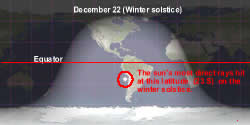Reasons
for Seasons
Exploring the Astronomy of the Seasons |
||
Teacher's Background Information
Watching the wave of spring sweep northward is at the heart of Journey North. All seasonal changes – temperature, plant growth and life cycles, animal migrations, and so on – are driven by shifts in the amount of available sunlight (called day length or photoperiod) and its intensity (related to the angle at which it strikes the Earth). Here's a refresher on key concepts, and a Season Simulator animation to demonstrate how and why changes in photoperiod and sunlight angle occur.
During our summer, the Northern Hemisphere leans toward the Sun in its revolution, there are more daylight hours, and the Sun’s angle is more perpendicular to us than at other times of year. The longer days and more concentrated sunlight result in more heating. (Shadows are shorter in the summer because the sun strikes Earth more directly.)
During
winter, the Northern Hemisphere leans away from the Sun, there
are fewer daylight hours, and the Sun hits us at an angle; this makes
it appear lower in the sky. There is less heating because the angled Sun’s
rays are “spread out” rather than direct. (Shadows are longer
because of the lower angle of the Sun.)
In equatorial regions, the length of days and the directness of sunlight
don't change as much. The further you get from the equator, the more dramatic
the seasonal changes.
During the spring and fall, the Earth leans neither toward nor away from the Sun; daylight and nighttime hours are more equal and temperatures are moderate. (The shadow of an object is similar during these seasons.)
Season Simulator
Click and drag the Earth around the Sun, or
play the animation, to see what's at the base of all seasonal
change.
Credit: Nebraska Astronomy Applet Project
Many students (and adults) believe that the Earth is closer to the Sun in the summer and further away in the winter. (It’s actually somewhat closer to the Sun in the winter, but the angled rays and short days don’t give us much heat.) Another misconception is that the Earth orbits the Sun in an elongated ellipse, which makes the Earth’s distance from the Sun dramatically different at different locations. The reality is that the Earth’s orbit is nearly circular.
Solstice refers to the two times each year when the Sun's strongest rays are furthest from the equator (north of it during our summer solstice and south during the winter). For the northern hemisphere, summer solstice occurs around June 21st; we have the maximum number of daylight hours at that time. Winter solstice is around December 21st when we have the fewest daylight hours.
Equinox refers to the two times each year when the Sun's strongest rays are directly hitting the equator. Everywhere on Earth has 12 hours of daylight on the spring and fall equinoxes. In the northern hemisphere, spring equinox occurs around March 21st and autumnal equinox around September 21st.

Winter
Solstice
in the Northern Hemisphere

Summer Solstice
in the Northern Hemisphere






